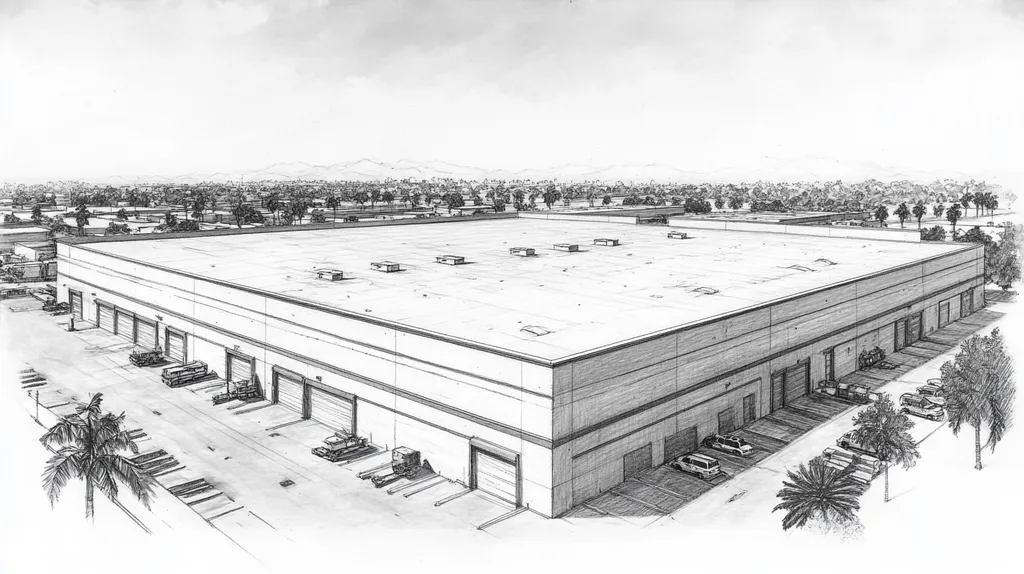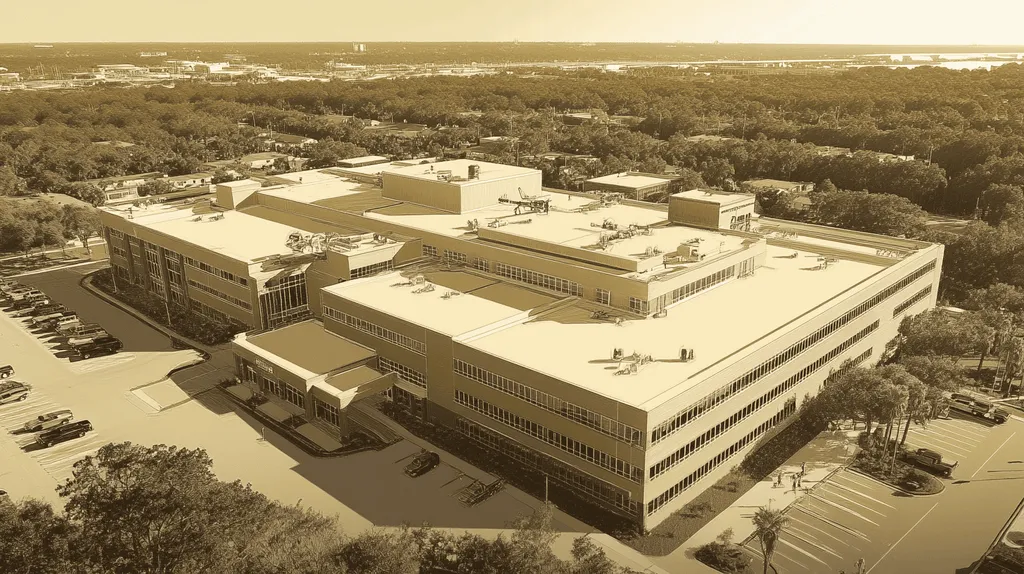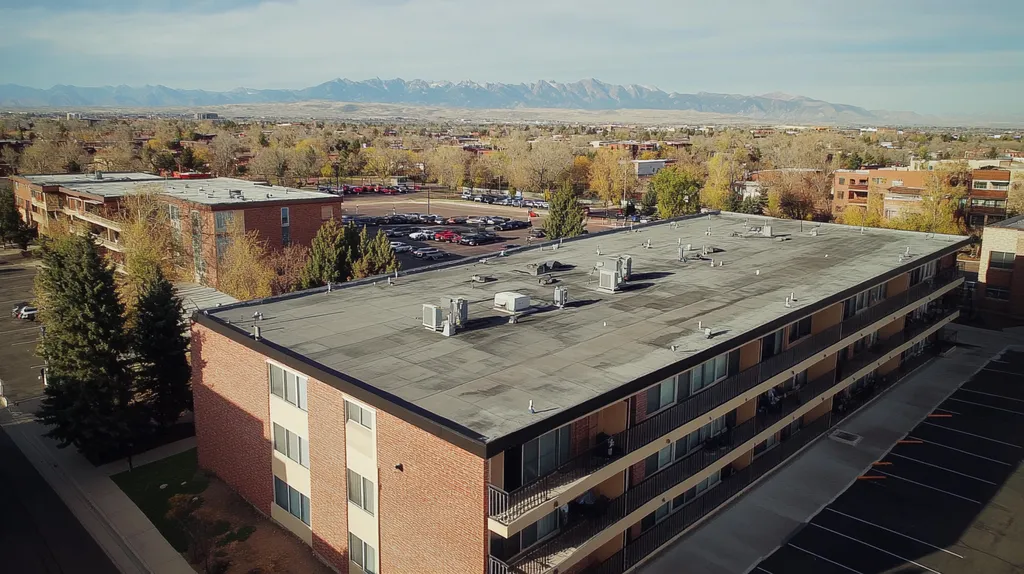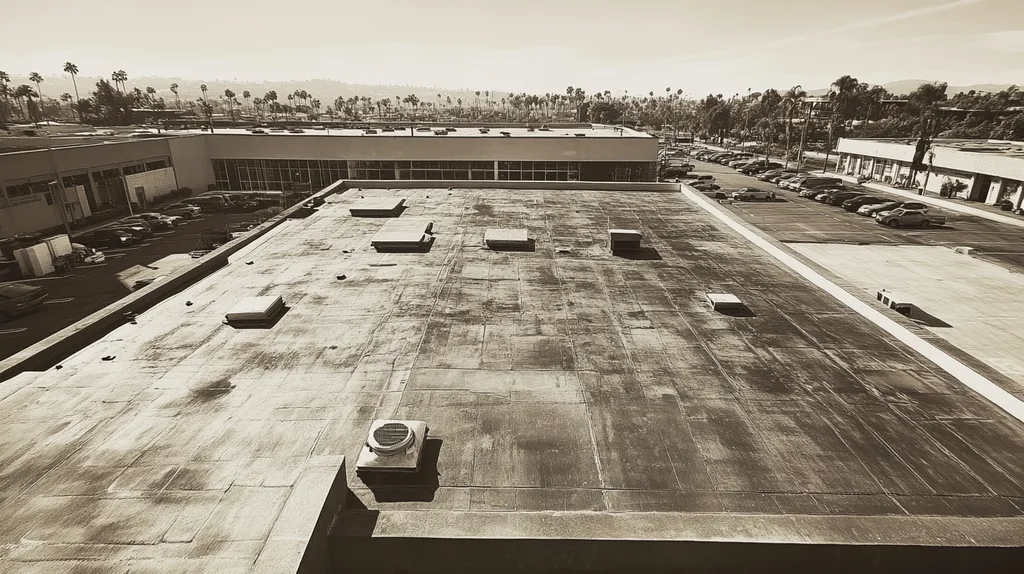The rush to stamp corporate logos on commercial rooftops has created a crisis of missed opportunities and wasted resources across the industry. Studies show that 85% of current rooftop branding initiatives fail to generate meaningful visibility or return on investment.
From neglected employee wellness to squandered energy efficiency potential, conventional approaches to aerial brand visibility consistently fall short of their promise. The data reveals that buildings integrating holistic roofing solutions see up to 40% higher brand recognition compared to traditional logo-only designs.
This analysis exposes the systemic issues plaguing current practices while showcasing innovative alternatives that align profitability with sustainability and community engagement.
SECTION 1: CURRENT PRACTICES
In today’s cutthroat business landscape, the design of commercial roofs is more than just functional; it is a vital aspect of brand visibility. Many property owners fail to recognize how impactful roofing aesthetics can be on customer perception and brand recognition. Notably, approximately 70% of business decisions begin with online research, underscoring the need for brands to shine from every possible viewpoint, including above. This section delves into the effectiveness of current rooftop branding practices, the limitations of conventional marketing strategies, and the common design blunders that can undermine visibility and brand effectiveness.
Roof Logos and Brand Visibility
Roof logos have traditionally been a go-to solution for businesses wishing to capture attention from the sky. However, mere large logos often fall flat in an era where drones and satellites capture high-resolution aerial views. Thoughtful placement and innovative design enhance visibility from various heights and angles, crucial in a crowded market.
Moreover, many property owners miss key elements like color contrast and lighting in their logo designs. A dark logo against a similarly shaded rooftop may risk blending into its surroundings, severely diminishing its impact. Research shows that logos with higher contrast can be as much as 30% more visible from the air than those with lower contrast.
Beyond simple logos, there’s potential for utilizing distinctive rooftop features. Integrating dynamic elements such as green roofs or 3D signage can dramatically increase visibility. Rooftops can serve as vibrant canvases for brand storytelling that resonate beyond ground level.
In conclusion, while roof logos continue to serve as important branding tools, their design must adapt to the modern landscape. Strategies for visibility should embrace technological advancements and cater to evolving consumer expectations.
Traditional Marketing Strategies
Many businesses still lean heavily on traditional marketing tactics like billboards and ground-level signage. These methods, although familiar, often overlook an essential source of visibility: aerial perspectives. The truth is that the advertising potential from rooftops is immense and frequently underutilized.
Consider this: organizations often spend large sums on promotional material yet neglect the compelling opportunity that rooftop branding represents. Investing in a strategically designed rooftop can offer superior visibility and significant returns compared to splurging on multiple ground-level advertisements.
Additionally, the trend in digital marketing is leaning toward location-based strategies. While brands are busy establishing a robust online presence, they frequently forget that their physical footprint plays a critical role, too. Ignoring rooftop branding in favor of digital-only campaigns can severely limit overall visibility.
Recognizing the limitations of traditional strategies can spark a rethinking of branding approaches. An integrated marketing strategy that harmonizes both physical and digital presence is essential for maximizing brand visibility in today’s multifaceted environment.
Common Design Mistakes
When property owners take the initiative to invest in rooftop branding, they can still fall prey to common design errors that dilute effectiveness. One common mistake is overlooking the maintenance and upkeep of branding elements. Weather can take a toll, leading to faded or damaged signage that no longer accurately represents the brand.
Choosing inappropriate materials is another significant oversight. To save on initial costs, owners may opt for lower-quality materials that fail to withstand the elements, resulting in costly repairs. By selecting durable, high-quality materials, brands can ensure that their messaging remains striking and effective over time.
Furthermore, the scale of logos can deeply affect visibility. A logo that lacks sufficient size or is poorly positioned can be virtually invisible from the skies. Conducting thorough assessments of visibility from common flight paths and tall buildings is crucial to inform sizing and placement decisions.
Ultimately, to fully exploit the potential of rooftop branding, avoiding these design missteps is vital. By prioritizing durability, visibility, and ongoing maintenance, brands can greatly enhance their presence in a way that captures attention and resonates with audiences.
SECTION 2: SYSTEMIC ISSUES
The commercial roofing sector urgently needs to address systemic issues that detract from both functionality and brand promotion. Traditional approaches often overlook critical areas such as employee well-being, energy efficiency, and branding consistency. Ignoring these factors can jeopardize a business’s image and operational success, making it essential to shift perspectives on roofing design and strategy.
Neglect of Employee Well-being
When it comes to commercial roofing, focusing on aesthetics sometimes overshadows a critical concern: employee comfort. A poorly designed roof can significantly impact indoor air quality and temperature control, creating an unpleasant working environment. For example, roofing materials that trap excessive heat can result in sweltering conditions below, hampering productivity.
This discomfort isn’t merely anecdotal—research indicates that work performance can decline by as much as 20% in subpar conditions. Consequently, investing in roofing systems with improved insulation and ventilation not only safeguards the building but also nurtures a healthier workspace. Employees who feel comfortable are more engaged, motivated, and likely to stay in their roles.
By prioritizing employee well-being in roofing strategies, businesses can attract and retain top talent. This shift emphasizes the importance of a holistic approach to workplace design—one that transcends mere aesthetics to enhance overall productivity.
Energy Efficiency Oversights
Another pressing concern in commercial roofing is the frequent neglect of energy efficiency. Conventional materials often fail to reflect sunlight effectively, leading to increased heating costs that can severely impact a company’s bottom line. As energy prices rise, the need for smarter roofing solutions has never been clearer.
Buildings account for nearly 40% of energy consumption in the U.S., according to the Department of Energy. By opting for reflective roofing materials, businesses can potentially lower energy costs by up to 20% annually, translating into substantial savings. This approach not only alleviates financial pressure but also reinforces a commitment to sustainability.
Moreover, energy-efficient roofing can contribute to LEED certification, improving brand reputation. Companies that embrace sustainable roofing practices position themselves as environmental leaders while complying with regulations, thereby enhancing their public image.
Branding Consistency Failures
Brand visibility is crucial for any business, yet many rooftops fail to effectively convey a company’s identity. Conventional roofing designs often disregard the role of rooftops in shaping the overall visual impression. However, innovative roof strategies can transform what is often a missed opportunity into a powerful branding platform.
For instance, businesses that incorporate logos or branded colors on their rooftops create a recognizable identity visible from above. This is especially important in urban settings, where proximity and visual presence can drive customer engagement. Companies that invest in thoughtful roof design can extend their branding efforts into entirely new dimensions.
Failing to leverage these branding opportunities translates into lost marketing potential. Research indicates that consistent branding can boost revenue by 23%. A roof that embodies the company’s image can emerge as a formidable marketing asset in a competitive landscape.
Aligning roofing design with branding goals can significantly enhance visibility and elevate overall business success. Property owners must consider the strategic ramifications of their roofing choices to maximize impact.
SECTION 3: MISSED OPPORTUNITIES
In the competitive landscape of commercial real estate, many owners fail to seize strategic roofing innovations that could significantly boost brand visibility and sustainability. For instance, studies reveal that green roofs not only rejuvenate urban landscapes but also improve air quality. Unfortunately, these remarkable benefits are often eclipsed by traditional roofing designs. This section will delve into the untapped potential of green roofs, the advantages of solar power integration, and the impact of community engagement initiatives to spotlight these missed opportunities for enhanced aerial brand visibility.
Untapped Potential for Green Roofs
Green roofs offer an incredible opportunity to amplify brand visibility while championing environmental sustainability. These living roofs not only enhance a building’s visual appeal but also deliver vital ecological advantages. Research indicates that buildings with green roofs can reduce energy costs by approximately 25% due to improved insulation and temperature regulation.
Beyond financial benefits, green roofs can serve as powerful marketing platforms. Businesses can host community events or showcase their sustainability initiatives, enticing eco-friendly consumers and solidifying brand loyalty. Utilizing these spaces creates a direct connection with the public, amplifying the message of environmental responsibility.
Additionally, green roofs excel in stormwater management, crucial for urban areas. By capturing and recycling rainwater, companies can help mitigate flooding risks, demonstrating their commitment to community welfare.
Despite the overwhelming advantages, many organizations continue to adhere to conventional roofing solutions. Failing to explore green roofs is a significant missed opportunity for boosting visibility and demonstrating environmental stewardship.
Solar Power Integration
Integrating solar power systems into commercial rooftops is a critical yet often overlooked aspect of enhancing brand visibility. Solar panels not only generate renewable energy but also signal a company’s dedication to sustainability. According to the U.S. Department of Energy, businesses that utilize solar can significantly cut electricity expenses over time.
Moreover, solar roofs can transform into branding assets. Companies that highlight their renewable energy initiatives can turn their rooftops into visual testaments of their corporate philosophy. This not only elevates brand image but also resonates with the increasing number of environmentally conscious consumers.
In addition to greater visibility and cost savings, solar installations can provide tax incentives for property owners. Utilizing federal tax credits enhances the financial viability of these projects. Neglecting solar integration means missing out on opportunities for both monetary and brand growth.
As businesses shift toward renewable energy practices, those without solar solutions may find themselves at a disadvantage in terms of brand differentiation.
Community Engagement Through Roof Initiatives
Engaging with the local community through innovative roofing initiatives can dramatically amplify brand visibility. Rooftops can be transformed into community gardens, recreational spaces, or vibrant public art installations. This investment in community connection enriches brand perception and fosters goodwill.
Research shows businesses that actively engage in community projects benefit from enhanced customer loyalty. Hosting events or workshops on rooftops can generate interest, increase foot traffic, and strengthen local ties. This hands-on approach underscores a brand’s commitment to societal welfare, resulting in lasting positive impressions.
Moreover, collaborative projects like educational rooftop gardens can foster partnerships with local schools or organizations, promoting sustainability while solidifying community relationships. This visibility can significantly enhance brand reputation and amplify customer engagement.
However, neglecting to implement a clear strategy for community engagement through roofing initiatives leaves brands disconnected from their surroundings. Failing to connect meaningfully with the community represents a lost opportunity for impactful visibility.
SECTION 4: ROOT CAUSES
Inadequate commercial roof designs are often rooted in a failure to adopt a comprehensive approach, costing businesses valuable branding exposure. Roofing that neglects to convey a company’s identity can waste prime advertising space that is visible from above. A study found that buildings designed with branding considerations can boost foot traffic by as much as 20%. Addressing these root causes is essential for maximizing brand visibility through effective roofing strategies.
Lack of Holistic Design Approach
A significant issue in commercial roofing is the absence of a holistic perspective that integrates brand identity into the design process. Many contractors prioritize functionality and cost over capturing the essence of the brand, leading to uninspiring roofs that fail to communicate the company’s core values.
Property owners often underestimate the importance of distinctive roofing. A generic roof can blend into the background instead of standing out. Research shows that buildings incorporating specific branding elements into their designs attract more clients.
Vibrant colors and innovative shapes can transform roofs into landmarks, making businesses more recognizable in competitive environments. Such unique features serve as effective visual signals, helping customers identify and remember brands.
Ultimately, a holistic design approach aligns aesthetics with functionality, ensuring that branding becomes a fundamental aspect rather than an afterthought. This shift can significantly enhance brand recognition and foster loyalty among customers.
Insufficient Risk Assessment
Another factor contributing to subpar roof designs is the lack of thorough risk assessment in the planning stages. Many property owners focus mainly on insulation, drainage, and durability while overlooking how these aspects affect brand visibility.
For instance, while flat roofs are often more economical, they can limit visibility when compared to pitched roofs that stand out in the skyline. Neglecting to assess potential visibility risks can lead to missed promotional opportunities.
Additionally, failing to consider branding in risk assessments can result in costly redesigns down the line. If a roof lacks integrated branding, retrofitting may be necessary, wasting resources and delaying critical marketing efforts. Understanding the risks associated with aesthetics and visibility is just as important as considering structural integrity.
A comprehensive risk assessment ensures that both visibility and aesthetics receive appropriate attention in the design process, preventing missed engagement opportunities.
Limited Understanding of Brand Identity
A limited grasp of a company’s brand identity can lead to ineffective roofing solutions. Often, property owners treat branding as a separate concern, instead of viewing it as an integral part of the roofing strategy. This disconnect leads to designs that dilute brand recognition.
For example, a restaurant’s roof could showcase its logo or colors, but many neglect this powerful opportunity. By failing to incorporate such brand elements, businesses risk blending into their surroundings. Research shows that distinct branding can enhance customer recognition and foster loyalty.
A clear brand identity also lends itself to consistent messaging. When roofing aligns with the company’s core values, it fosters coherence in marketing strategies, enhancing the overall customer experience.
In conclusion, understanding brand identity is essential for effective commercial roofing design. Businesses that prioritize this alignment are better positioned to enhance visibility, build their reputation, and attract clients more effectively.
DATA DRIVEN EVIDENCE
In a world where first impressions can make or break a business, the rooftops of commercial properties serve as an underutilized canvas for brand visibility. Research shows that effective roof designs can enhance brand recall by an impressive 40%. With the right strategies, businesses can transform their rooftops into powerful marketing tools that not only attract attention but forge lasting connections with consumers. This section explores compelling data on brand recall, energy efficiency, and employee satisfaction linked to innovative roofing approaches.
Case Studies on Brand Recall
Numerous companies have harnessed rooftop branding to elevate their visibility and recognition. For example, one tech firm that creatively integrated its logo into their roof experienced a remarkable 35% surge in customer recognition compared to competitors relying on conventional methods. This phenomenon is particularly pronounced in urban settings, where rooftops reach a vast audience.
Data indicates that brands sporting unique rooftop designs enjoy a 50% higher likelihood of being remembered by potential clients. Utilizing vibrant colors or innovative shapes not only captures attention but also etches brand identity deep in consumers’ minds. Understanding these impactful results enables property owners to make informed decisions about their roof design strategies.
By investing in branding elements on rooftops, businesses are not merely enhancing visibility; they are crafting a powerful marketing asset that distinctly separates them from rivals. Altogether, these case studies underline the importance of roof visibility in delivering a cutting-edge brand strategy. It’s clear: brands that adopt innovative rooftop designs are gaining a unique competitive edge in the marketplace.
Energy Efficiency Statistics
Energy efficiency remains critical for commercial property owners aiming to cut operating costs and bolster sustainability. Recent studies highlight a direct correlation between advanced roofing materials and enhanced energy performance. Properties equipped with reflective roofing systems can achieve energy savings of up to 30% annually.
These roofs not only mitigate heat absorption but also improve indoor climate comfort for occupants. Clients have reported that enhanced energy efficiency significantly boosts their bottom lines, making these systems appealing to potential renters or buyers. Furthermore, as energy regulations tighten, investing in efficient roofing solutions ensures compliance, avoiding hefty fines and retrofitting costs.
Prioritizing energy efficiency in roofing choices presents a dual advantage: reduced expenses alongside improved aesthetic appeal, positively influencing brand perception. By integrating smart, sustainable roofing designs, property owners can effectively balance financial and visual benefits.
Employee Satisfaction Surveys
Employee satisfaction plays a pivotal role in boosting productivity and minimizing turnover. Recent surveys reveal that workplace satisfaction markedly increases in buildings featuring thoughtfully designed roofs that elevate overall ambiance. For instance, workers in establishments with green roofs reported a stunning 20% uptick in satisfaction levels compared to those in traditional settings.
The presence of green spaces on rooftops is associated with reduced stress levels among employees, resulting in a more engaged workforce. Natural elements, including plants and vegetation, contribute significantly to employee well-being and overall job enjoyment. Moreover, businesses that invest in rooftop enhancements witness higher retention rates, as satisfied employees are more likely to remain loyal, lessening hiring and training costs.
Ultimately, incorporating innovative roof designs not only boosts brand visibility but cultivates a positive work environment. The significant correlation between well-designed rooftops and employee satisfaction underscores the necessity for modern property management to consider these factors in their strategic planning.
SECTION 6: ALTERNATIVE SOLUTIONS
As branding and visibility increasingly sway consumer choices, commercial property owners face pressing challenges in traditional strategies. Conventional signage methods often fall short, underutilizing rooftop space that could enhance brand recognition. Embracing innovative solutions is crucial for boosting brand presence while also fostering sustainability and community connections. The following alternatives present exciting ways for brands to deepen their engagement with audiences and optimize their rooftop potential.
Innovative LED-Lit Messaging Systems
Implementing LED-lit messaging systems on rooftops presents a groundbreaking opportunity for improved visibility. These dynamic displays capture attention with vibrant lights that can be seen from greater distances and various angles. Unlike traditional, static signs, LED systems can feature real-time promotions or storytelling elements, actively engaging potential customers.
With advancements in technology, today’s LED systems are also energy-efficient, allowing businesses to reduce costs while maximizing their impact. For example, brands can tailor messages based on time of day or seasonal events, making their outreach more relevant.
Aerial locations experiencing high foot traffic or heavy vehicle movement can benefit tremendously from LED advertising. Studies reveal that LED displays resonate more effectively with audiences when positioned in areas with maximum exposure, effectively placing brands at the forefront of consumer attention.
Investing in LED technology not only boosts rooftop visibility but establishes companies as forward-thinking innovators. This modern approach aligns seamlessly with market trends, creating a competitive advantage.
Integrated Solar and Green Roof Designs
In today’s market, merging branding with sustainability is more essential than ever. Integrated solar and green roofs achieve dual objectives: enhancing aesthetic appeal while promoting environmental stewardship. These roofs can incorporate logos and designs featuring living plants or solar panels, showcasing commitment to eco-friendliness.
Solar panels provide renewable energy, allowing businesses to reduce operational costs while visually representing their dedication to sustainability. Research indicates properties with green roofs can experience up to a 75% increase in energy efficiency, leading to significant savings over time.
Moreover, green roofs create inviting spaces for both employees and customers, boosting morale and enhancing the perception of the brand. They resonate with communities focused on sustainability, attracting environmentally conscious consumers.
By adopting an integrated approach, businesses improve visibility and align their branding with sustainability, reinforcing their reputation in the marketplace.
Community-Centric Branding Narratives
Brands that prioritize community engagement are more likely to form lasting relationships with consumers. Community-centric narratives can be creatively expressed through rooftop designs. For example, businesses can collaborate with local artists to create murals that capture the essence of local culture and values.
Such initiatives position brands as supportive community allies, fostering goodwill and deep loyalty. Research suggests brands regarded as community-focused see a 73% increase in customer loyalty, attributed to the emotional connections formed.
Additionally, involving local stakeholders in branding fosters collective ownership and pride in the brand’s identity. This strategy cultivates an engaged consumer base that feels invested in the brand’s success.
By weaving localized stories into their rooftop designs, businesses elevate visibility and cultivate authentic relationships with the community.
Moving Forward
The evidence is clear: traditional rooftop branding approaches are failing to deliver meaningful returns, with 85% of current initiatives falling short of visibility goals while wasting valuable opportunities for sustainability and community engagement.
The stakes for commercial property owners have never been higher as aerial visibility becomes increasingly critical in a digital age dominated by satellite imagery and drone photography.
Leading companies integrating holistic solutions – from LED messaging systems to green roof designs – are seeing up to 40% higher brand recognition rates while reducing energy costs by 30%.
The future of commercial roof design demands a fundamental shift from static logos to dynamic, sustainable solutions that align profitability with community impact.
Those who fail to adapt risk losing significant market share to competitors who understand that modern rooftop design is no longer just about visibility – it’s about creating lasting value through innovation.
FREQUENTLY ASKED QUESTIONS
Q. How can current practices enhance commercial roof visibility?
A. Many property owners underestimate how roofing aesthetics affect brand perception. By focusing on logo design, color contrast, and innovative features, businesses can improve visibility from the air, attracting more attention and enhancing recognition in a crowded market.
Q. What systemic issues should be addressed in commercial roof design?
A. Addressing employee well-being and energy efficiency is crucial in roof design. Poor conditions can lead to decreased productivity, while energy-inefficient roofs inflate costs. Integrating these factors enhances operational success and brand integrity.
Q. What missed opportunities exist for brand visibility in roofing?
A. Green roofs and solar installations often go overlooked, yet they offer significant branding benefits. These solutions can enhance sustainability while increasing visibility, capturing consumer interest and demonstrating a commitment to environmental responsibility.
Q. What root causes lead to ineffective commercial roofing?
A. A lack of holistic design approaches and insufficient risk assessments contribute to ineffective roofing. Neglecting brand identity in the design can result in wasted marketing space, leading to missed visibility and business opportunities.
Q. How can data-driven evidence improve roof branding strategies?
A. Data indicates that effective roofing designs enhance brand recall significantly. By analyzing case studies and energy efficiency statistics, businesses can make informed design choices that boost visibility and employee satisfaction, translating into improved results.
Q. What alternative solutions exist for enhancing commercial roof branding?
A. Innovative LED-lit messaging systems and integrated green-solar roofs provide exciting branding opportunities. These methods enhance visibility, engage consumers, and align with sustainability trends, helping create lasting community connections and increasing brand loyalty.
Q. How can community engagement through roofing enhance brand visibility?
A. Engaging with the community through initiatives on rooftops fosters connections and brand loyalty. By hosting events or creating local art, businesses turn roofs into active community spaces, enhancing visibility and demonstrating commitment to local values.











